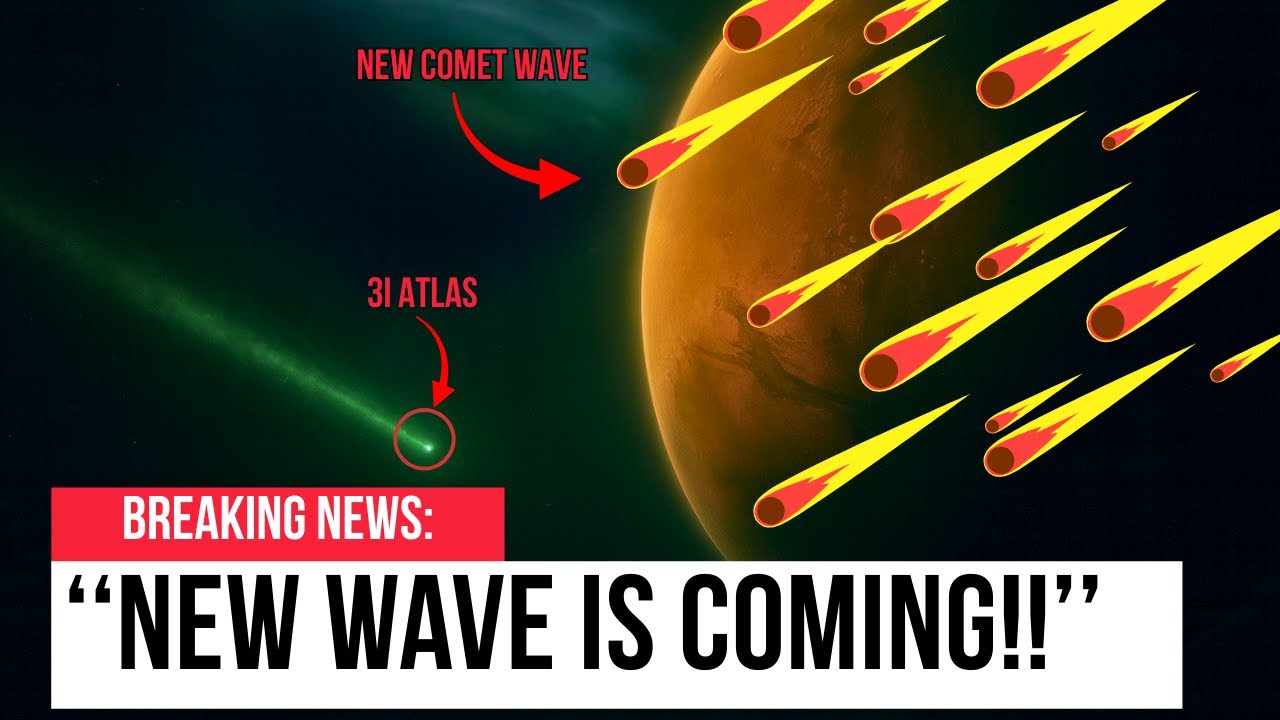🚨 BREAKING: Mystery Objects Are ‘Multiplying’ Around 3I/ATLAS as It Zeroes In on Mars – Is This a Swarm from Deep Space? 🤯
Deep in the asteroid belt, something bizarre is unfolding: As the interstellar beast 3I/ATLAS races toward Mars at 130,000 mph, new faint streaks are popping up in telescope feeds like a cosmic convoy. Scientists are stunned – are these fragments breaking off, or the start of a massive wave of alien comets flooding our system? NASA’s on high alert, but the truth could rewrite everything we know about visitors from the stars.
Peel back the layers on this escalating enigma. 👉

The vast expanse between Jupiter and Mars, long a graveyard of shattered rocks and forgotten debris, is suddenly alive with whispers of intrusion. As Comet 3I/ATLAS – the third confirmed interstellar wanderer to pierce our solar system – hurtles toward a razor-close flyby of the Red Planet, telescopes are picking up a flurry of new, faint objects trailing in its wake. What started as a solitary enigma back in July has ballooned into a potential swarm, with astronomers debating whether these “multiplications” signal a natural fragmentation or the vanguard of a broader wave of comets ejected from some distant stellar nursery. With NASA’s fleet of probes locked on and ESA’s Mars orbiters gearing up for October’s showdown, the stakes feel higher than ever – not just for planetary defense, but for our grasp on the galaxy’s hidden traffic.
It was a routine sweep on July 1, 2025, when the ATLAS telescope in Chile’s Río Hurtado valley flagged the intruder: a faint, fast-moving speck at 4.5 astronomical units (AU) from the Sun, roughly 416 million miles out. Dubbed 3I/ATLAS for its interstellar origins and discoverer, the object clocked a hyperbolic path screaming through at 58 kilometers per second – too quick to be snared by our Sun’s gravity, destined for a slingshot exit by early 2026. Early peeks from Hubble and the Canada-France-Hawaii Telescope revealed a reddish coma of dust and gas, faint tail stubs, and a nucleus pegged at 1 to 5 kilometers wide – bigger than ‘Oumuamua, but no doomsday rock. No Earth-crosser, either; its closest shave with us is a safe 1.8 AU in December. But Mars? That’s the hotspot, with a 0.19 AU (28 million km) brush on October 3, close enough to stir the planet’s thin air and light up orbital cams.
By mid-September, as 3I/ATLAS plunged into the asteroid belt at 3.5 AU, the plot thickened. Ground-based scopes like the Very Large Telescope in Chile and Gemini South started logging anomalies: alongside the main comet, ephemeral blips – new point sources, some streaking, others hovering like echoes. “It’s like the comet’s shedding companions,” said David Jewitt, UCLA astronomer and Hubble lead, in a recent briefing. Initial counts pegged four to six “offshoots,” faint at magnitude 18-20, but their numbers ticked up to a dozen by September 18, per data from the Zwicky Transient Facility. Are they fragments from a mid-belt graze? Or harbingers of a cluster, flung our way eons ago from the Milky Way’s chaotic core?
Theories split the room faster than a solar flare. Conservative voices at NASA’s Jet Propulsion Lab point to fragmentation: as solar heat at 2 AU now vaporizes the comet’s CO2-heavy ices (87% by mass, per SPHEREx infrared scans), chunks could shear off, mimicking a multiplying fleet. James Webb Space Telescope (JWST) spectra from August 6 confirmed the odd brew – water ice at an 8:1 underdog to CO2, laced with nickel vapor and cyanogen sans typical carbon chains. “This isn’t your garden-variety ice ball,” noted Olivier Doré, SPHEREx project scientist. “It’s dry, ancient – maybe 4.5 billion years old, kicked out during its home system’s youth.” A subsurface rupture, triggered by tidal stresses or a micrometeor hit in the belt, could explain the burst: heavy dust jets birthing pseudo-comets, each with mini-comas glowing green from unknown emitters.
But the “wave” hypothesis has legs, too, fueled by archival digs. NASA’s Transiting Exoplanet Survey Satellite (TESS) unearthed pre-discovery shots from May 2025, showing 3I/ATLAS as a dim smudge amid a scatter of similar faint movers – up to 20 in stacked frames, per a fresh Astrophysical Journal Letters paper. “These aren’t random; they’re kin,” argued lead author Alex Feinstein of the University of Chicago. Models from Princeton’s Amir Siraj suggest interstellar objects (ISOs) like this aren’t loners: the galaxy’s Oort-like clouds spew trillions, with one ISO statistically lurking inside Pluto’s orbit at any time. If 3I/ATLAS is the tip, its “multiplications” might be siblings, gravitationally herded from Sagittarius toward our ecliptic – a 0.2% fluke path that hugs Venus (0.7 AU post-perihelion), Jupiter (0.36 AU in March 2026), and now Mars.
Skeptics wave it off as optical ghosts: asteroid belt clutter, amplified by the comet’s glare, or processing artifacts in long-exposure plates. Lindley Johnson, NASA’s Planetary Defense Officer, struck a measured tone in a Debrief interview: “We’ve seen outbursts before – think C/2024 S1 disintegrating last year. No evidence of a swarm yet; these ‘new objects’ are likely ejecta.” ESA chimes in similarly, prepping Mars Express and ExoMars Trace Gas Orbiter (TGO) for October 3 sweeps with OMEGA and NOMAD spectrometers to sniff volatiles from the main body – and any tagalongs. NASA’s MAVEN and rovers Perseverance and Curiosity might catch nightside glints, probing coma swell as solar proximity peaks.
Yet the fringe is firing on all cylinders. Harvard’s Avi Loeb, ‘Oumuamua’s loudest cheerleader, dropped an arXiv preprint September 15 positing the “multiplications” as deliberate: “If not natural shedding, this could be deployment – probes fanning out for reconnaissance.” His planetary preparedness index clocks 3I/ATLAS at a 5 now, up from 4, citing non-grav speeds and the ecliptic sync. Online, X (formerly Twitter) erupts: @ISOHunter42’s thread on “comet convoy” racked 3,200 likes, sharing SOHO frames of streaky anomalies near the comet’s projected arc. @DeepSpaceWhisp tied it to a “wave event,” quoting SETI’s Seth Shostak: “ISOs are our free samples from exoplanets – but a cluster this tight? That’s no accident.” @AstroConspiracyMan went viral with 1,800 retweets, claiming VLT nickel traces scream “manufactured hulls,” echoing 2021 comet finds.
Mainstream pushback is firm. Karen Meech of the University of Hawaii, who co-discovered ‘Oumuamua, called the swarm talk “premature hype” in a Sky at Night piece: “We’re dealing with a relic from another system’s dawn – CO2-rich, water-poor, a window on alien chemistry. Let’s not ET it up yet.” Northeastern’s Jacqueline McCleary echoed: “This could illuminate why our Oort Cloud’s comets differ – high CO2 ratios hint at cooler birthplaces.” But as 3I/ATLAS vanishes behind the Sun at perihelion (1.36 AU on October 29-30), blind spots loom: two weeks of radio silence, reemerging dimmer, faster at 152,000 mph.
The Mars rendezvous amps the drama. At 0.19 AU, tidal pulls might accelerate any real fragments, turning “multiplications” into a detectable train. ESA’s Juice en route to Jupiter could snag peripherals; NASA’s Juno, post-orbit tweak, eyes a November peek. Parker Solar Probe might brush the inner fringes come late October, sampling any plasma wake. If the wave holds – say, 20+ objects confirmed by TGO spectra – it bolsters models of galactic ejection: protoplanetary disks flinging herds during giant impacts, per Oxford’s Chris Lintott. “Affordable flybys are feasible,” he mused, eyeing future ISO chasers.
For now, the belt’s bustle feels like a prelude. Is 3I/ATLAS a lone fossil, crumbling under our Sun’s gaze? Or the scout for a deluge, proving ISOs as the Milky Way’s most populous nomads? As Jewitt put it: “We’re peeking at the universe’s underbelly – and it’s messier, more crowded than we thought.” With auroras flickering from solar winds and grids humming warily, October’s Mars date looms as the reveal. Keep scopes trained; the stars might just be replying.





